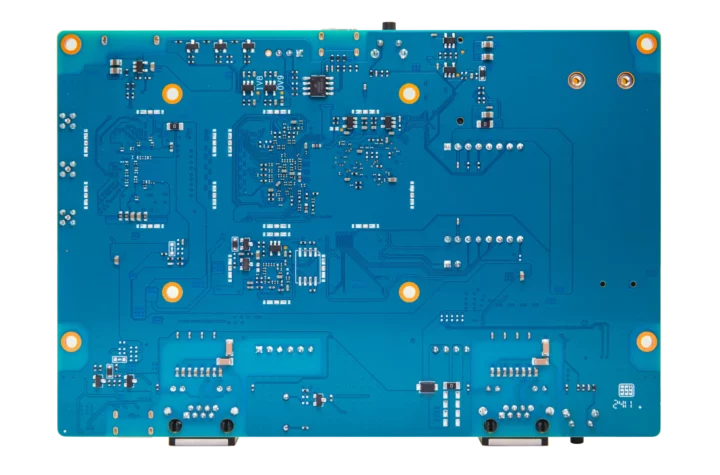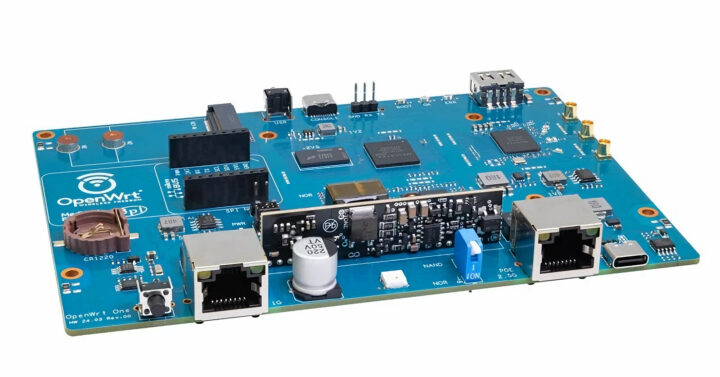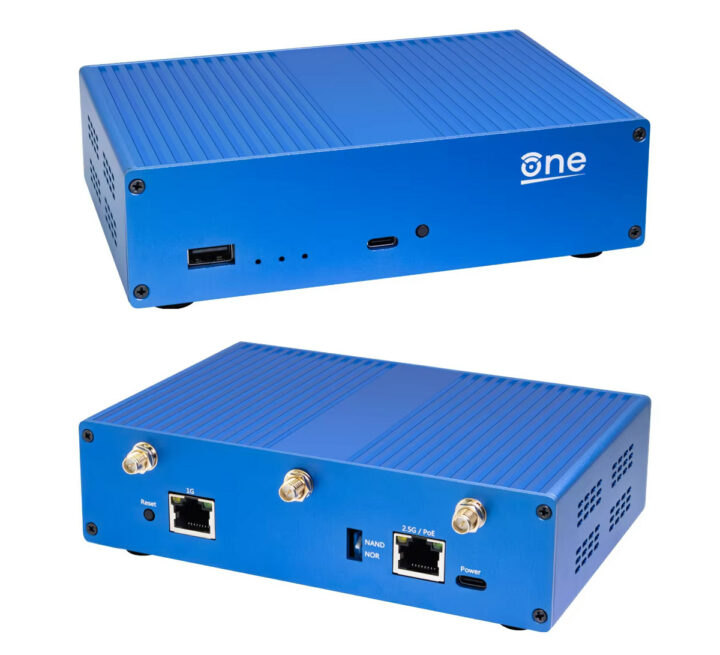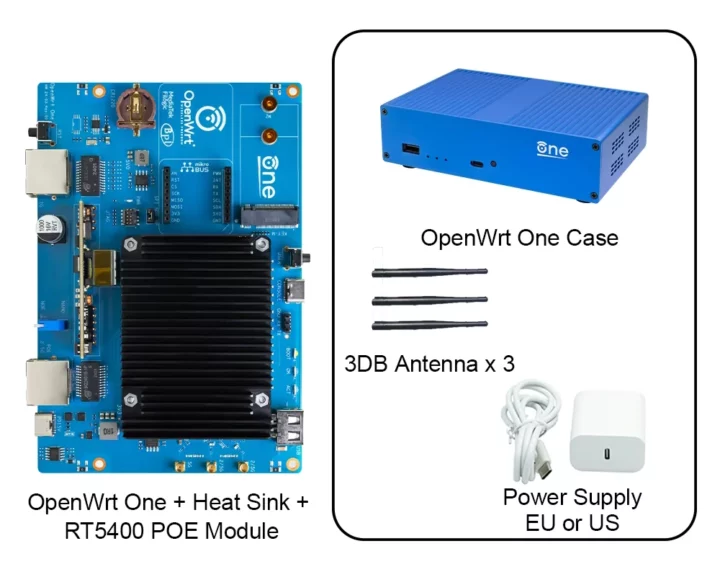The “OpenWrt One/AP-24.XY” is a Filogic 820-based WiFi 6 router board manufactured by Banana Pi whose software is directly managed by OpenWrt developers with assistance from MediaTek.
The router was first announced in January 2024, and developer samples became available sometime in April with some early units auctioned away at the OpenWrt Summit which took place in Cyprus on May 18-19. The good news is that the OpenWrt One is now available to anyone on Aliexpress for $89 including a metal enclosure, a PoE module, three antennas, and a power supply.
Here’s a reminder of the OpenWrt One router specifications:
- SoC – MediaTek MT7981B (Filogic 820) dual-core Cortex-A53 processor @ 1.3 GHz
- System Memory – 1GB DDR4
- Storage
- 128 MB SPI NAND flash for U-boot and Linux
- 4 MB SPI NOR flash for write-protected (by default) recovery bootloader (reflashing can be enabled with a jumper)
- Two types of flash devices are used to make the board almost unbrickable
- M.2 2242/2230 socket for NVMe SSD (PCIe gen 2 x1)
- Networking
- 2.5GbE RJ45 port
- Gigabit Ethernet RJ45 port
- Dual-band WiFI 6 via MediaTek MT7976C (2×2 2.4 GHz + 3×3/2×2 + zero-wait DFS 5Ghz)
- 3x MMCX antenna connectors
- USB
- 1x USB 2.0 Type-A host port
- USB Type-C (device, console) port using Holtek HT42B534-2 UART to USB chip
- Expansion – MikroBUS socket for expansion modules
- Debugging – Console via USB-C port or 3-pin header, 10-pin JTAG/SWD header for main SoC
- Misc
- Reset and User buttons
- Boot select switch: NAND (regular) or NOR (recovery)
- 2x PWM LEDs, 2x Ethernet LED (GPIO driven)
- EM6324 External hardware watchdog
- NXP PCF8563TS (I2C) RTC with battery backup holder for CR1220 coin-cell
- Power Supply
- 12V USB-PD on USB-C port (might have changed to up to 15V)
- 802.3at/af PoE via RT5040 module
- Dimensions – 148 x 100.5 mm compatible with Banana Pi BPI-R4 case design
- Certifications – FCC/EC/RoHS compliance
 The OpenWrt One router is directly supported by the developers, and you’ll already find a snapshot build for the latest OpenWrt image on the website. However, there’s no stable release such as OpenWrt 23.05.5 right now since it’s so new. The documentation is available on Banana Pi and OpenWrt websites with the former focusing on the hardware part.
The OpenWrt One router is directly supported by the developers, and you’ll already find a snapshot build for the latest OpenWrt image on the website. However, there’s no stable release such as OpenWrt 23.05.5 right now since it’s so new. The documentation is available on Banana Pi and OpenWrt websites with the former focusing on the hardware part.
You’ll receive a complete router with a blue metal enclosure. There’s also a large heatsink attached to the board for cooling covering the main components such as the MediaTek Filogic 820 SoC, DDR4, and SPI NAND flash chips.
Update: This article was first published on April 17, 2024 right when the first samples became available, and updated following the public release on Aliexpress.

Jean-Luc started CNX Software in 2010 as a part-time endeavor, before quitting his job as a software engineering manager, and starting to write daily news, and reviews full time later in 2011.
Support CNX Software! Donate via cryptocurrencies, become a Patron on Patreon, or purchase goods on Amazon or Aliexpress









So close, yet so far. Better luck next time.
Can you elaborate about what you don’t like about this product?
This is just terrible product to celebrate OpenSource project – one that cant run without closed source software.
Its ironic to name a Project OpenWrt that can run on hundrets of different wifi routers with 100% free software and then the single first product after 20 years that carry the name of the project itself is one that can not run with just free software and need closed source binary firmware to get wifi working.
I’d love a firmly supported openwrt router but with my ISP moving beyond gigabit I need at least 2x 2.5gbe ports. It’ll have to be the bpi-r3 or r4 even if they risk being janky.
Why do they even bother with the 2.5gbe, i don’t see the point if there is only one.
2.5x more bandwidth, obviously. Number of ports doesn’t matter if you plug the board into managed switch and use vlans.
I don’t think that companies who have 2.5+gbe managed switches are gonna want to use openwrt on a Chinese board.
What is a ‘Chinese board’ and why would one fear something like that?
System Memory – 1GB DDR4 = FAIL!
@tkaiser said: “What is a ‘Chinese board’ and why would one fear something like that?”
You FEAR THE CHINESE BOARD because through that hijacked device Pooh Bear has his head so far up your ass he is licking your balls – just for fun. That’s why!
Yeah, that’s their problem. Other people have 2.5x more bandwidth. 😀
with 2.5Gbit uplink you have bandwidth for both wifi and 1GBit ethernet. And lot of people actually use wifi only for internet access so one 1GBit LAN port is more than enough for some. And did you notice you can nowadays have speeds over 1GBit just via ax wifi?
What is the interrest of this board ? Sorry but it’seems obsolète already ? No ?
Well, it has the tech specs of the EspressoBin released 7 years ago, but in a larger form factor. I think it’s safe to assume that 7 years starts to count as obsolete in the network domain 🙂
This has quite modern AX wifi 6 dual band chip, it is quite unlikely EspressoBin had this 7 years ago.
It had a mini-pcie slot so this is even better, you can plug what you want and even update it to stay at top speed as new standards emerge. An AX210 WiFi 6E card advertising up to 2.4 Gbps costs only $20. That’s not worth the hassle of buying a complete new system, reinstall and reconfigure everything.
Yes, this can be true when the system is more expensive. In my case I was thinking about upgrading old router and new concurrent dual band ax card was in $50-$60 range (and two separate cards for 5 and 2.4 were even more expensive in total). New router was $34 and draws 1/3 of the power of old system (~5 vs ~15Watts) and has faster CPU.
it was never meant to be a top tier router but a reference board for openwrt hobbyists like me 🙂
Do the mediatek chip have any advantage for routing over a cheaper x86 chip? Considering that you have to buy a power supply, SSD and etc.
I believe that for most consumers, it doesn’t really matter as consumer routers would just go to the ISP router which will do the actual intra and inter routing.
What people would really want is firewall usage and other such applications which then this is probably underspecced for.
most consumers don’t really know what a firewall is so …
Wow, im underwhelmed.
A board that fits the needs of a handful of tinkerers and nobody else’s.
The USB serial console is mostly unnecessary, as they have serial headers, and every $1 USB to serial board will do.
The POE module, that most users won’t need, drives the cost up. Why not simply use a socket instead?
No switch, no SFP. USB2 host? GTFO.
And why MMCX antenna connectors? On a board that big, they could’ve used angled SMA to directly connect antennas.
Seriously, what use case does this thing even fit?
POE is optional, the rest is driven by cost, it has only what Filogic 820 gives you ‘for free’, switch is another chip. angled SMA means they would decide antenna locations for you. Personally I like it if the cost will be reasonable for what it is. I currently have Xiaomi AX3000T which is same platform but I’d like more expandablity this thing has (USB, PCI-E, SPI). I have no use for builtin switch, one WAN and one LAN port is enough.
WRT54G had a switch at least!
Share details on how to contribute for this OpenWRT One community? Also where this reference board can be ordered?
DDR5?It should be DDR4.
Why would a well known open source project like openwrt even consider to work with the well known GPL violators from sinovoip/banana-monkeys?
Why?
In that case, Banana Pi only handles the hardware, so software should not be a problem.
Great note! Noone should work togeter with GPL violators. Allwinner is also for example a known GPL violator and noone should buy new allwinner hardware so that the company see financial issues when violating GPL.
Sadly the OpenWrt one hardware is based on Mediathek SoC and those can not run with just free software when you want working WiFi. And becausse this is a WiFi Rourer, OpenWrt should have never chosen a WiFi chipset that require closed source softwate to run. This is just terrible product to celebrate OpenSource project – one that cant run without closed source software.
My understanding is that this WiFi chip is supported as part of the opensource mt76 driver (a variant of 7996), look here:
https://github.com/openwrt/mt76/blob/master/mt7996/init.c
I am not aware of a single wifi chipset supported by the mt76 driver that can run without loading a closed source firmware.
The most recent Wifi chip which works without proprietary firmware, I am aware, of are the Atheros Wifi 4 devices (now QCA as part of Qualcomm) with ath9k driver. The wifi in the MT7981 supports Wifi 6 and requires a small proprietary firmware which is running on a seperate CPU in the Wifi chip itself and not inside the Linux kernel or user space. The mt76 Wifi driver for the MT7981 used in the OpenWrt One is open source and integrated in mainline Linux kernel. All other drivers used in the default firmware for the OpenWrt One are also open source and mostly integrated in the upstream Linux kernel and U-Boot.
The Atheros Wifi 4 chips are now mostly end of life and the Mediatek Wifi 6 performances much better. For an access point with open source drivers Mediatek is currently the best choice. The Intel client Wifi support AP mode only on the 2.4GHz band and has a big firmware restricting the firmware. The recent QCA open source ath11k drivers for their Wifi 6 chips are not very stable and also require a big firmware.
Hello Hauke(core OpenWrt dev). Thanks for confirming, that there are wifi-asics available that can run with 100% opensource software but OpenWrt have chosen to take a chipset that require closed source software to run – and then print proudly on OpenWrt logo on it.
I am aware of all what you told. Thats why i wrote that above. You just confirmed that.
If OpenWrt One should be just some additional WiFi router, then you should had to take LibreRouter https://www.cnx-software.com/2020/01/29/librerouter-is-an-open-source-hardware-router-for-community-networks/ and just print OpenWrt logo on it and call it OpenWrt One.
If you would had liked to release something revolutionary, then you should had taken https://github.com/open-sdr/openwifi and make WiFi 6 but also wifi ha-low and much more available with it on a custom FPGA+SDR board named OpenWrt One.
Now to celabrate 20 years of OpenWrt a terrible company named MediaTek have been chosen just because NBD sadly works there.
To summarize: The overall conclusion is just really sad. A project named OPEN.. chose a ASIC from a known bad company that can not run with just OPEN source software.
As a user I don’t care much about opensource firmwares because I don’t intend to hack on them. However, I do care a lot about opensource drivers because I don’t want to be constrained to use a specific BSP kernel. As such, for me there are 3 main degrees for vendors: fully proprietary, proprietary firmware with open driver, fully open. It seems that these days, the only fully open products are essentially re-implementations of outdated technologies. In the examples you gave above, there’s only 2.4 GHz WiFi 4. Not only that’s slow and will not attract any customer, but nobody wants 2.4 anymore to see network disruption every time their neighbor heats coffee in their microwave oven.
So both projects and hardware vendors have to adapt to end user expectations in hope to sell something and see their project succeed. Being able to rely on mainline code is already a great step forward IMHO. That doesn’t mean we should not encourage to do more, but it at least means that it’s important not to put in the same bag vendors of fully closed software (that force you to run unknown stuff into your operating system and sees all your data) and those of closed firmware (that force you to run unknown stuff into your wifi card but not on your OS). As soon as you consider the wifi card as part of the network infrastructure, it’s not worse than being connected to a switch running non-free code, or connecting your cell phone to a non-free 4G/5G base station etc.
Only one choice if your neighbours microwave negatively impacts your pron consumption -> wear a tin foil hat and do some gish gallop!
“If you would had liked to release something revolutionary” no, they wanted to release something that works well and is relatively cheap and is as much opensource as currently possible and practical. Please stop trolling. If you know how to do it better then please do so, then people will be standing in line to get your router instead for sure.
It does not look like it really launched. These are probably still just samples?
Status update from september 2024 https://lists.openwrt.org/pipermail/openwrt-devel/2024-September/043144.html and no other news any time later in their mailing list
I updated this post after receiving a message from Banana Pi claiming that “OpenWrt one have public sale”.
Well maybe since BananaPi does the hardware side for OpenWrt they did some first batch, sent samples to OpenWrt guys and sold the rest via
https://forum.banana-pi.org/t/openwrt-one-ap-24-xy-public-sale-openwrt-community-official-board/19094 ?
see the sentence “To buy sample ,please visit document center “easy to buy sample”
So maybe they are doing public sale of samples via their aliexpress shop?
From the Sep 6 status OpenWrt update:
* I’m planning to send out 30 units to selected contributors beginning
of next week.
* The FCC/CE/RoHS certification process has started. Samples are on
their way to the labs for testing.
this does not look like final release can be done in a month.
The product is now out of stock on the AliExpress link, so the supply was either limited or the demand was pretty high.
the listing says 38 sold
OpenWrt Two is planned for the end of 2025.
The new hardware partner will be GL.iNet. Upgrades from OpenWrt One:
* MediaTek MT7988
* 10Gbps SFP
* 5Gbps copper
* 4 port 2.5Gbps copper
* 1-2 port 1Gbps copper
* Tri-band Wi-Fi 7
Target price: $250
https://openwrt.org/voting/2025-02-12-openwrt-two
That’s going to be serious specs… Also I have more faith in glinet than banana pi to deliver a good and complete product.